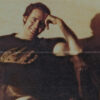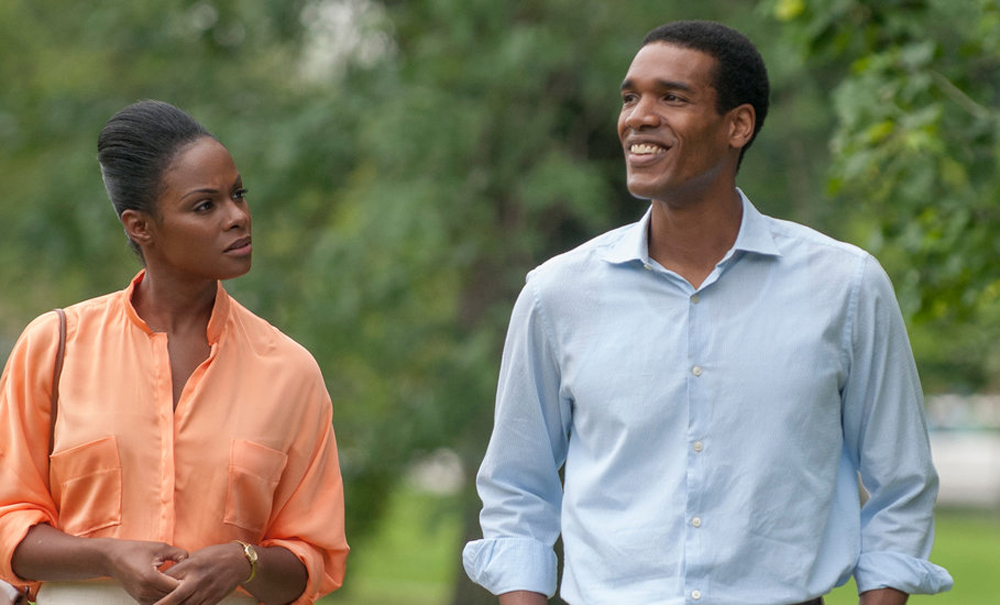As if he didn’t have enough to worry about playing Barack Obama as a 27-year-old law student, it was at 7:30 in the morning of the day he was supposed to shoot another scene that Parker Sawyers learned that he’d be giving an address to a church full of people that becomes the centerpiece of Richard Tanne’s romance “Southside with You.”
“The steadicam guy didn’t show up – a scheduling mishap, so Rich comes to me at 7:30 in the morning and says, “Dude, we have to do the speech today,” Sawyers recently recalled, seemingly unfazed by the abrupt scheduling change.
Unfazed by his response, Tanne said, “[We did] 30 to 40 takes within eight [camera] setups, and he messed up three words [the whole time].”
You wouldn’t know of even those slight slip-ups from the final product, in which the future president of the United States may not be exactly the fully polished orator we know today — particularly when desperately trying to woo Michelle Robinson (Tika Sumpter), his supervisor at the Chicago legal firm he interned at during a summer away from Harvard, over the course of a day spent in the Windy City — but still bearing the disarmingly seductive rhetorical skills that made him such a formidable politician. The scene is also just one of many in “Southside With You” where the complex is made to look deceptively simple as the first date of the Obamas covers as much ground physically as it does intellectually. As the two take in a show of Ernie Barnes’ paintings at the Art Institute of Chicago, visit the Music Box Theatre to see “Do the Right Thing” and in between make time for the aforementioned stop to the church to discuss a community center that Michelle thinks is the reason for their meeting, their conversation causes the neurons to flare and the heart to pitter-patter as they passionately discuss Gwendoline Brooks, their career ambitions, and their ice cream preferences.
While Michelle’s defenses steadily wear down against Barack’s charm offensive, the same effect is bound to happen to audiences, who may be skeptical of a presidential portrait unlike any other, made and released while #44 is still in office and presents him as a romantic lead. However, the weight of knowing where the date is headed allows the film an understated, delicate quality as writer/director Tanne hones in on the small gestures and moments of increasing intimacy that made the two fall in love. Naturally, it was just a glance between the couple that inspired Tanne to start working on “Southside With You,” writing the film at his father’s house in Roseland, New Jersey in “obscurity,” as he describes it, unsure if the script would see the light of day. On the eve of “Southside with You”’s release, the filmmaker, who is now working on a script for Pixar, spoke about how ignorance turned out to be bliss in envisioning the Obamas’ first date, how his own love life affected the story he wanted to tell and putting the audience right in the pews for that showstopping church scene.

The interesting thing is the movie was fully-formed from the time I read about the first date. [Michelle] was not interested, she gave [Barack] a day to prove himself and he proved himself, and they went to these various locations along the way. Beyond referencing it in interviews, there wasn’t a lot of information about what took place on the date, so it’s not like I had to bend the movie to what the facts of the first date were, and I was using established biographical fact to inform what these two characters would talk about and what they might’ve clashed over and what might’ve connected them.
And I just kept going back to this idea. Finally around 2013, I just felt ready to write it — I had fallen in love [myself] around 2011 and had an epic first date and the deeper my relationship got and the more I felt like I was changing for the better because of this other person, the more I realized that’s what the story was about. That’s probably the moment you’re talking about where it’s like I get that now. I know what that feels like and I wanted to depict that.
The first scenes of the film, showing Michelle and Barack preparing for the day, are such a clever way to set the tone for the film since it removes any distance between them and the audience. Was it obvious to start the film in demystify who these people were so you can tell your story?
No, and I even remember giving the script to one of my best friends, who’s a screenwriter, to read after I finished writing it to ask for feedback. He said starting the movie with someone doing their makeup and a guy sitting and smoking a cigarette is not the most dynamic way to start a screenplay, and I think conventional wisdom would agree with that, but for me, it was obvious because it signaled to the audience, this is not going to be the biopic that you think it’s going to be. It needed to start with the minutiae of each of their lives — you’re going to see him reading a book in a chair and you’re going to see her, sitting down, looking in the mirror, getting ready for the day and putting her clothes on because that’s what the movie is [because you need] the small little details and the small little moments to create a credible version of this.

I appreciate you picking up on that because whether it’s Demme or Adrian Lyne, who was a big visual touchstone for the movie, I wanted that kind of heightened naturalism in the lensing, which you saw a lot of in the mid- to late ‘80s. Without having a lot of money, that kind of gauzy, hazy, grainy quality that [makes you feel] like “Hey, this looks like a movie that could have come out in that time” was a really quick way to orient the viewer to the time period.
They go to an Ernie Barnes show at the Art Insitute and eventually, his paintings accompany the end credits. How did his work become such a part of this?
I knew that I wanted the paintings they looked at [during their visit to the Art Center] to inspire a wide-ranging conversation between the two of them. It needed to be the first time they get personal about things and the artwork needed to be bold enough to take things to a slightly deeper level than they previously had, not only in the scenes before but also offscreen at the office. I had always loved Ernie Barnes’ work, which I had seen on “Good Times,” and I don’t remember the moment when I started looking at his work for this film — it probably involved a more general search about Afro-centric artwork, but I gravitated towards Mr. Barnes because his work covers such a vast spectrum of the black experience in this country. That really enabled the characters to talk about a lot of different things.
One of the film’s showstopping scenes takes place inside a church where Barack is invited to speak to the community. His gift for rhetoric is certainly on display, but you wisely avoid shooting him with reverence, staying in the pews. How did you decide to cover that scene?
Actually, the way I filmed that and some of the other cinematic rules that I set up with my DP came about from reading Gordon Willis [interviews]. He was very rigid about the perspective that the camera should take on. In particular with “The Godfather,” he and Francis Ford Coppola made it possible so you could switch characters perspectives in the scene – so I could be subjective to Barack, I could be subjective to Michelle, and what they’re feeling and experiencing. Usually, picking a perspective is a good way to go, but what about when you’re just an observer? Willis’ calculation was that we should never have a God-like, omnipotent perspective because that reminds the audience that they’re watching a movie and it takes away credibility. Coppola disagreed at times, so they sometimes broke that rule, but for the most part when you watch [“The Godfather”], you’re either [seeing the scene through] one of the characters’ perspective or you’re watching it play out from some unknown person [in the background], like in the back of the church during the christening scene or sitting in the back of the car as they’re riding along. So that’s what I wanted to do. I didn’t want to get ahead of where the characters were, I wanted to be there grounded in the moment with them and I think that plays into the reality of it.

Even before you heard actors speaking the words, was it an interesting thing for you to find the cadence and the rhythm of it? It gets Michelle and Barack’s speech patterns in a way that’s not over pronounced.
Without sounding too pretentious about it, I just did my homework and then I felt connected to the versions of the characters that I wanted to portray. As a writer yourself, I’m sure you understand how you can really get tapped into a subject and then the work does itself, so once I got the two characters talking — and in that nice snappy banter [with] the challenging nature that they have with one another, like a verbal volley — I found their voices.
Since you’ve describing making this largely in obscurity, what’s the experience of getting attention for it?
It’s very strange. I feel pretty stupid because in retrospect, of course a movie about the two most famous people in the world is going to get attention. But I just never really thought about it. It constantly feels like a surprise that anyone is interested in this little movie, and yet I understand intellectually why they are, but it still surprises me.

Yeah, I think it’s safe to say that it’s different. I produced a couple micro-budget indie movies that don’t reflect my sensibility, but those were a great experience Nothing of mine as a writer/director has really been out there, and [directing] was very much what I imagined it to be. It’s hard, grueling work every day and you have to stick to your guns to safeguard your vision. You have to be vigilant about every aspect. You have to be detail-oriented and push yourself every day to do the best work and push the people around you to do their best work. This was a highly expedited shoot, so I look forward to having more time and a bit more resources on the next one, if I’m lucky enough to make one, but in its own grueling, challenging way, it was quite a bit of fun.
“Southside With You” opens on August 26th.




